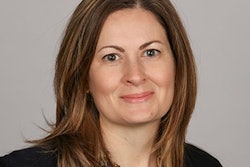Washington, D.C.-based Gallaudet University, like all colleges and universities nationwide, faced the decision of whether to bring students back to campus for the fall semester amid the ongoing COVID-19 pandemic.
Gallaudet ultimately decided to offer all courses remotely. However, on-campus priority housing was given to up to 100 students who are DeafBlind, experience an unsafe home, have no other viable housing options and/or need support resources for online learning. The semester began Aug. 31 and will end Dec. 18.
“Students generally understand and appreciate the reasons for our decision to go online this fall, although they have let us know that they miss being on campus in a language-rich environment and seeing their peers and professors,” says Dr. Jeffrey W. Lewis, interim provost at Gallaudet.

Under Gallaudet’s reopening plans, the key areas of health, safety, technological and academic support and the student experience were highlighted. Tuition was also reduced by 15% for all full-time and part-time students.
In fall 2019, 41% of the incoming cohort during fall 2019 had zero expected family contribution. Of that percentage, 66% were students of color, an increase from 38% from the year before. The total number of students of color enrolled last fall was 51%, the highest number seen by the university, according to Dr. Thomas P. Horejes, associate provost of student success and academic quality at Gallaudet.
Additionally, in fall 2019, 58% of all undergraduate and graduate students came from families with incomes below $60,000. Additionally, 60% of the undergraduate students were Pell Grant-eligible, reported Horejes.
“Going forward, we must ensure that fiscal barriers are minimal when obtaining a higher education,” he adds.
Due to financial barriers, some students lacked access to technological resources needed to complete their virtual classes. During the switch to online learning in March, the university loaned notebook computers, webcams and MiFi devices to students. This semester, students and faculty received Apple iPad Pros, Apple Pencils and Apple Smart Keyboard Folios.
“Many of our students struggle with the impact of COVID-19 on their personal lives, including not just their health and employment, but that of their families,” says Horejes. “This in turn impacts their ability to focus on their studies. To address this challenge, we are following the principle of ‘do no harm’ and encouraging our faculty to exercise flexibility when working with them, both in and out of the classroom.”
A disproportionate impact
Though the effects of remote learning have become prevalent across the higher education sector, deaf students’ social experiences have been more impacted, according to Dr. Khadijat K. Rashid, interim dean of the faculty at Gallaudet.
Rashid says that, as part of deaf students’ college experience, there is “value in language and cultural vibrancy.”
“They come to Gallaudet to obtain a greater sense of deaf identity through language immersion for new signers and language vibrancy, in the same way that Black students attend HBCUs for that experience,” she adds. “On top of reducing their financial barriers, we also feel that it is not fair to charge them the same tuition rate as if they were learning face-to-face.”
Remote learning can serve as a challenge for all students but remains even more difficult for deaf students.
“Like all college and university students, deaf students want the full ‘college experience,’” says Lewis. “They face unique challenges because they learn visually through American Sign Language. Staring at a computer screen for hours at a time is challenging. We have had to ‘mix up’ our approach to teaching.”
To prepare for virtual learning, more than 93% of faculty participated in training. During the online sessions, faculty received training on programs such as Quality Matters and Blackboard Ultra.
There was also a focus on developing “culturally-responsive and trauma-informed pedagogy and bilingual approaches to teaching,” said Lewis. Students will undergo similar training.
“Although we have removed the burden of worrying about on-campus teaching and work from our faculty and staff, they still face other issues,” he adds. “Including schooling for their children, worry about their parents and extended family, the increasing number of COVID cases within the community and other social, economic and political factors that the pandemic has highlighted.”
Gallaudet will also launch the “First 40-Day” campaign as a way to keep students engaged throughout the semester by hosting virtual activities including webinars, workshops, student-run debates, e-gaming and exercise programs.
On-campus protocol
For the limited number of students, faculty and staff on campus this fall, face coverings — including clear masks — and social distancing have been mandated. The use of shared and public spaces will be restricted and each room for on-campus students will be single occupancy. There will also be mandatory COVID-19 testing before arriving on campus and large events are cancelled for the semester.
Support services such as tutoring, academic advising, career services, disability services and counseling and psychological services has continued. However, Gallaudet’s athletics were cancelled for the fall.
Lastly, to create an inclusive and safe campus environment, the university established a small group of student ambassadors who work remotely to support “the health and safety response to the global pandemic and its ongoing, multi-faceted anti-racism commitment.”
As the semester progresses, the public health mandates from the District of Columbia will continue to be monitored and the reopening plans updated accordingly.
Despite the challenges brought on by the pandemic, Gallaudet has seen positive retention and enrollment rates. According to Horejes, when the transition to online learning occurred in mid-March, more than 99% of the students completed the semester.
As of Aug. 14, total enrollment is higher by 0.7% compared to last year, which stems from an increase in graduate degree-seeking student enrollment, says Dr. Genie Gertz, interim dean of undergraduate admissions at Gallaudet.
Additionally, as of Aug. 19, 137 of 183 first-time, full-time freshmen from fall 2019 registered for this upcoming semester. This equates to a 75% fall-to-fall retention rate. If the rate remains the same through September, the retention rate will tie for the second highest in five years and the third highest in ten years, said Dr. Gaurav Mathur, dean of the Graduate School of Research and Continuing Studies at Gallaudet.
“Our faculty and staff appreciate that they do not have to worry about their health or their families in order to do their jobs this fall,” says Lewis. “We have not yet made a decision about spring 2021, but we will continue to monitor federal and local laws, regulations and guidance, as well as our own guiding principles. We are committed to communicating all decisions as early as possible.”
This article originally appeared in the September 17, 2020 edition of Diverse. You can find it here.



















